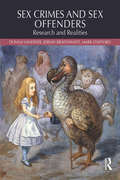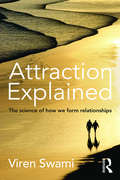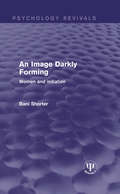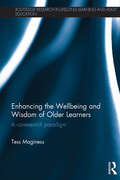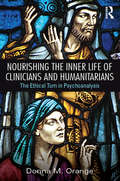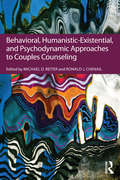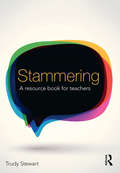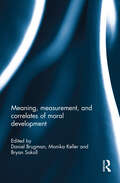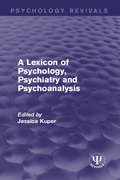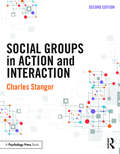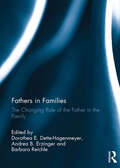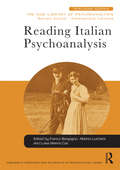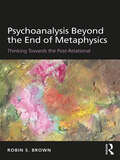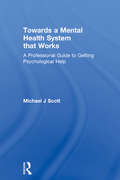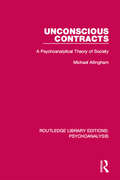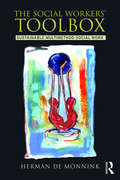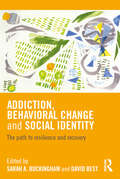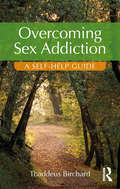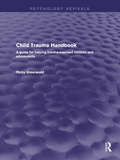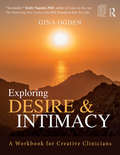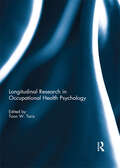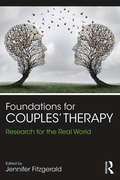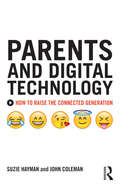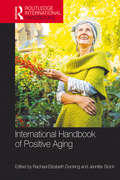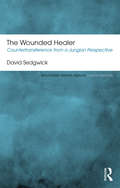- Table View
- List View
Sex Crimes and Sex Offenders: Research and Realities
by Donna Vandiver Jeremy Braithwaite Mark Stafford<p>Sex Crimes and Sex Offenders: Research and Realities provides an overview of social scientific theory and research on sex crimes and sex offenders. Most other books on the market are focused on a single issue—such as treatment, rape, pedophilia, theory, etc. This book is unique in that it covers the most current theory and research along with individual cases of sex crimes (e.g., Kobe Bryant, Jerry Sandusky, and other case studies), effectively linking theory and research with the realities of sex crimes and sex offenders as well as their victims. <p>Vandiver, Braithwaite, and Stafford are careful to dispel myths and to focus on the heterogeneity of sex crimes and sex offenders, and not on any one issue or population or theory. Instead, they weave a framework using a full range of theoretical concepts and research data to integrate their discussions of crimes, offenders, victims, treatments, and policy implications. The result is a valuable resource for students and early-stage researchers investigating sex crimes or offenders.</p>
Attraction Explained: The science of how we form relationships
by Viren SwamiHow much does appearance matter in the formation of romantic relationships? Do nice guys always finish last? Does playing hard-to-get ever work? What really makes for a good chat-up line? When it comes to relationships, there’s no shortage of advice from self-help ‘experts’, pick-up artists, and glossy magazines. But modern-day myths of attraction often have no basis in fact or – worse – are rooted in little more than misogyny. In Attraction Explained, psychologist Viren Swami debunks these myths and draws on cutting-edge research to provide a ground-breaking and evidence-based account of relationship formation. At the core of this book is a very simple idea: there are no ‘laws of attraction’, no foolproof methods or strategies for getting someone to date you. But this isn’t to say that there’s nothing to be gained from studying attraction. Based on science rather than self-help clichés, Attraction Explained looks at how factors such as geography, appearance, personality, and similarity affect who we fall for and why.
An Image Darkly Forming: Women and Initiation (Psychology Revivals)
by Bani ShorterOriginally published in 1987, a well-known Jungian analyst, the late Bani Shorter writes here about how women are initiated into becoming themselves. Her book was an important contribution to the field of analytical psychology at the time, as well as to the increasingly popular study of women’s spirituality. In former times transitions from one stage of life to another were prepared for and marked by ritual initiation; in modern times this necessity is overlooked and women’s natural development is made more difficult as a consequence. Through working in close therapeutic relationships with women, Bani Shorter found that when challenged by crises and transitions in their lives, today’s women instinctively create rituals nevertheless to mark their journey towards maturation, wholeness and meaning. In this process they discover something of who they are and recognise dimensions of themselves which have been previously repressed and undreamed of. The stories unfolded here can be a guide for all women through their own rites of passage.
Enhancing the Wellbeing and Wisdom of Older Learners: A co-research paradigm (Routledge Research in Lifelong Learning and Adult Education)
by Tess MaginessEnhancing the Wellbeing and Wisdom of Older Learners: A Co-research Paradigm examines how lifelong learning, becoming wise, and sharing wisdom are integrally linked to older people’s wellbeing. The book highlights appropriate learning styles and pedagogies for older people, including research models emphasising participation, and offers recommendations for research in lifelong learning with the potential to effect change. Focusing upon a collaborative action research project, ‘Sagaciation’, chapters explore the involvement of older learners in the design and delivery of the scheme, which enabled them to expand their knowledge and skills, and to fully engage as critical and creative voices in a supportive and welcoming environment. The book offers an account of the process of the action research, as well as its findings. The project is set into the context of leading academic thinking on fields such as the growth of an ageing population, the rise of literature on ageing, negative and positive constructions of ageing, social gerontology, the wellbeing and health of older people, and educational gerontology. This book challenges negative representations of older people as a burden by offering a paradigm of hope, resilience, and sagacity within education and beyond. It will appeal to researchers, academics and postgraduate students in the fields of adult education, lifelong learning, gerontology, mental health and wellbeing, and the sociology of education, as well as to policymakers and those working with older people
Nourishing the Inner Life of Clinicians and Humanitarians: The Ethical Turn in Psychoanalysis
by Donna M. OrangeNourishing the Inner Life of Clinicians and Humanitarians: The Ethical Turn in Psychoanalysis, demonstrates the demanding, clinical and humanitarian work that psychotherapists often undertake with fragile and devastated people, those degraded by violence and discrimination. In spite of this, Donna M. Orange argues that there is more to human nature than a relentlessly negative view. Drawing on psychoanalytic and philosophical resources, as well as stories from history and literature, she explores ethical narratives that ground hope in human goodness and shows how these voices, personal to each analyst, can become sources of courage, warning and support, of prophetic challenge and humility which can inform and guide their work. Over the course of a lifetime, the sources change, with new ones emerging into importance, others receding into the background. Donna Orange uses examples from ancient Rome (Marcus Aurelius), from twentieth century Europe (Primo Levi, Emmanuel Levinas, Dietrich Bonhoeffer), from South Africa (Nelson Mandela), and from nineteenth century Russia (Fyodor Dostoevsky). She shows how not only can their words and examples, like those of our personal mentors, inspire and warn us; but they also show us the daily discipline of spiritual self-care, although these examples rely heavily on the discipline of spiritual reading, other practitioners will find inspiration in music, visual arts, or elsewhere and replenish the resources regularly. Nourishing the Inner Life of Clinicians and Humanitarians will help psychoanalysts to develop a language with which to converse about ethics and the responsibility of the therapist/analyst. This is an exceptional contribution highly suitable for practitioners and students of psychoanalysis and psychotherapy. Donna M. Orange teaches, consults, and offers study groups for psychoanalysts and gestalt therapists. She seeks to integrate contemporary psychoanalysis with radically relational ethics. Recent books are Thinking for Clinicians: Philosophical Resources for Contemporary Psychoanalysis and the Humanistic Psychotherapies (2010), and The Suffering Stranger: Hermeneutics for Everyday Clinical Practice (2011), both from Routledge.
Behavioral, Humanistic-Existential, and Psychodynamic Approaches to Couples Counseling
by Michael D. Reiter Ronald J. ChenailCouples counseling is distinct from individual and family therapy and, while ideas from these other formats may be overlapping, applying theoretical concepts to couples has distinctive challenges. Behavioral, Humanistic-Existential, and Psychodynamic Approaches to Couples Counseling is unique in that it addresses how to conceptualize various theories around a single case. By discussing only one case, the reader is more readily able to compare and contrast the theoretical ideas of each theory, as well as the pragmatics of techniques. Five theories are discussed around four consistent parts: history, theory of problem formation, theory of problem resolution, and case transcript.
Stammering: A resource book for teachers (Overcoming Common Problems Ser.)
by Trudy StewartWhat is stammering? How does it present itself? When does it occur? Why does it happen? What are the most effective strategies you can use to help? Providing background information about stammering as well as a wide range of tools and strategies, this practical book addresses the key challenges faced at nursery and school. There are separate sections on early years, primary and secondary level and include the most common areas that teachers must consider when supporting children who lack speech fluency, including: identifying children at risk of developing a stammer how to manage incidents of stammering how to manage classroom communication and oral participation helping children to make and maintain relationships help children to manage feelings associated with stammering working alongside speech and language therapists. Recent changes to the curriculum means that there is now a greater demand on children’s communication skills than ever. This book will help you provide the necessary support to a child who stammers by offering a clear explanation of the presentation of stammering and the best ways you manage the occurrence of stammering in a range of school contexts. Full of tips and advice this book will enable teachers and other professionals to work effectively with a child who stammers. This accessible book is essential for anyone concerned about a child in their care who presents with a stammer, including teachers, student teachers, SENCOs and parents.
Meaning, measurement, and correlates of moral development
by Daniel Brugman, Monika Keller and Bryan SokolMorality has once again become an important focus of research in different scientific disciplines, from biology, neuroscience and evolutionary psychology, to social psychology, economics, and political philosophy. One of the reasons for this renewed interest stems from the tragedies that human beings, individually or in groups, inflict upon the lives of one another and the world at large, tragedies such as war, the extinction of species and ecological destruction, climate change, and last but not least – the financial crisis. Moral destitution and collapse, a lack of respect for human dignity and worth, and deficits in proper moral functioning at all levels of the world community, often discounted or masked by transparent excuses and vacuous rationalizations, are all viewed as principal causes of the social, societal and ecological crises with which we are confronted today. The key to solving these crises must lie, at least partly, in a better understanding and active deployment of morality. Developmental psychology is charged with the specific task of illuminating the growth and evolution of moral functioning in human beings. This book was originally published as a special issue of the European Journal of Developmental Psychology.
A Lexicon of Psychology, Psychiatry and Psychoanalysis (Psychology Revivals)
by Jessica KuperOriginally published in 1988, this volume provides a broad and eclectic view of psychological theory, methods and practice, covering not only the main branches of academic psychology but also psychiatry, psychoanalysis and other psychotherapies. Although some research and practices will inevitably have moved on, it will still be an ideal companion for students and a useful work of reference for mental health professionals, and indeed for anyone interested in contemporary scientific thinking about the human brain, mind and personality.
Social Groups in Action and Interaction: 2nd Edition (Psychology Ser.)
by Charles StangorSocial Groups in Action and Interaction reviews and analyzes the human group as it operates to create both social good and, potentially, social harm. It summarizes current knowledge and contemporary research, with real-world examples in succinct yet engaging chapters, to help students understand and predict group behavior. Unlike other texts, the book considers a wide range of topics--such as conformity, leadership, task performance, social identity, prejudice, and discrimination--from both an intragroup and an intergroup perspective. By looking at behavior both within and between groups, it bridges the gap between these interconnected approaches. The second edition is thoroughly updated to include new discussion of the biology and neuroscience of group formation, recent developments in social identity theory, and recent advances in the study of social networks. It also includes questions for review and discussion in the classroom. It provides the most comprehensive and essential resource for courses on group dynamics and behavior.
Fathers in Families: The Changing Role of the Father in the Family
by Dorothea E. Dette-Hagenmeyer, Andrea B. Erzinger and Barbara ReichleThe role of the father in a family and for his children has varied greatly throughout history. However, scientific research into fatherhood began relatively late at the end of the 1960s and early 1970s, with a strong focus on the impact of the father on child development. This book focuses on the role of the father in the contemporary two-parent heterosexual family. Of eight longitudinal studies from several Western countries, six focus on the socialization outcomes of the children, and two concentrate on parental satisfaction. Although the father is in focus, family dynamics cannot be conclusively described without a look at the mother and parental interaction. Therefore, all of the studies examine mothers and their role in the family system. Thus, the book gives a contemporary insight into the father and his role in changing family dynamics. This book was originally published as a special issue of the European Journal of Developmental Psychology.
Reading Italian Psychoanalysis (New Library of Psychoanalysis Teaching Series)
by Franco Borgogno Alberto Luchetti Luisa Marino CoeWinner of the American Board & Academy of Psychoanalysis Prize for best Edited book published in 2016 Psychoanalysis in Italy is a particularly diverse and vibrant profession, embracing a number of influences and schools of thought, connecting together new thinking, and producing theorists and clinicians of global renown. Reading Italian Psychoanalysis provides a comprehensive guide to the most important Italian psychoanalytic thinking of recent years, including work by major names such as Weiss, E.Gaddini, Matte Blanco, Nissim Momigliano, Canestri, Amati Mehler, and Ferro. It covers the most important theoretical developments and clinical advances, with special emphasis on contemporary topics such as transference, trauma and primitive states of mind where Italian work has been particular influential. In this volume, Franco Borgogno, Alberto Luchetti and Luisa Marino Coe of the Italian Psychoanalytical Society provide an overview of how Italian psychoanalysis has developed from the 1920’s to the present day, tracing its early influences and highlighting contemporary developments. Forty-six seminal and representative papers of psychoanalysts belonging to the two Italian psychoanalytical societies (the Italian Psychoanalytical Society and the Italian Association of Psychoanalysis) have been chosen to illuminate what is special about Italian theoretical and clinical thinking, and what is demonstrative of the specificity of its psychoanalytic discourse. The selected papers are preceded by a first introductory section about the history of psychoanalysis in Italy and followed by a "swift glance at Italian psychoanalysis from abroad". They are grouped into sections which represent the areas particularly explored by Italian psychoanalysis. Each section is accompanied by introductory comments which summarize the main ideas and concepts and also their historical and cultural background, so as to offer to the reader either an orientation and stimulus for the debate and to indicate their connections to other papers included in the present volume and to the international psychoanalytic world. The book is divided into six parts including: History of psychoanalysis in Italy Metapsychology Clinical practice, theory of technique, therapeutic factors The person of the analyst, countertransference and the analytic relationship/field Trauma, psychic pain, mourning and working-through Preverbal, precocious, fusional, primitive states of the mind This volume offers an excellent and detailed "fresco" of Italian psychoanalytic debate, shining a light on thinking that has evolved differently in France, England, North and Latin America. It is an ideal book for beginners and advanced students of clinical theory as well as experienced psychoanalysts wanting to know more about Italian psychoanalytic theory and technique, and how they have developed.
Psychoanalysis Beyond the End of Metaphysics: Thinking Towards the Post-Relational
by Robin S. BrownWinner of the Theoretical Category of the American Board & Academy of Psychoanalysis Book Prize for best books published in 2016 Psychoanalysis Beyond the End of Metaphysics offers a new paradigm approach which advocates reengaging the importance of metaphysics in psychoanalytic theorizing. The emergence of the relational trend has witnessed a revitalizing influx of new ideas, reflecting a fundamental commitment to the principle of dialogue. However, the transition towards a more pluralistic discourse remains a work in progress, and those schools of thought not directly associated with the relational shift continue to play only a marginal role. In this book, Robin S. Brown argues that for contemporary psychoanalysis to more adequately reflect a clinical ethos of pluralism, the field must examine the extent to which a theoretical commitment to the notion of relationship can grow restrictive. Suggesting that in the very effort to negotiate theoretical biases, psychoanalytic practice may occlude a more adequate recognition of its own evolving assumptions, Brown proposes that the profession’s advance requires a return to first principles. Arguing for the fundamental role played by faith in supporting the emergence of consciousness, this work situates itself at the crossroads of relational, Jungian, and transpersonal approaches to the psyche. Psychoanalysis Beyond the End of Metaphysics will be of significant interest to all psychodynamically oriented clinicians, alongside scholars of depth psychology and the philosophy of mind. It will also be helpful to advanced and postgraduate students of psychoanalysis seeking to orient themselves in the field at present.
Towards a Mental Health System that Works: A professional guide to getting psychological help
by Michael J ScottResearch has established that there are efficacious psychological therapies for most common mental disorders. In Towards a Mental Health System That Works, psychologist Michael J Scott details the reforms necessary to ensure that consumers of services receive an evidence-based treatment. This book examines: the social significance of interventions that target mental-wellbeing and psychological disorder why treatments are ‘lost in translation’ from research to routine practice steps that can be taken towards a translation that better recognises the complexity of research and ensures fidelity to an evidence-based treatment protocol the deleterious effects of current provision on clients and therapists. Towards a Mental Health System that Works is a valuable resource for therapists, mental health practitioners, Clinical Commissioning Groups and politicians, enabling them to critically evaluate service provision, distil what constitutes cost-effective evidence-based mental health practice across the whole spectrum of disorders and client populations, and chart a new direction. It also serves as a guide to consumers of mental health services, as well as their friends and family, allowing them to understand what they are likely to experience and what they can demand.
Unconscious Contracts: A Psychoanalytical Theory of Society (Routledge Library Editions: Psychoanalysis #1)
by Michael AllinghamOriginally published in 1987 this highly original work explores how the nature and institutions of society are determined by our unconscious as well as our conscious aims – how individuals join together in ‘unconscious contracts’. The author does this by integrating psychoanalysis and social science to generate a psychoanalytical theory of society. The key to this theory is the interpretation of both psychoanalysis and social science in terms of the interplay between conflict and co-operation. Professor Allingham starts by discussing the workings of the individual mind, and tracing the development of the adult personality from its roots in infancy. He uses this background to show how the group acts as a key link between the individual and society, and the sense in which groups have lives of their own. He completes the theory by demonstrating how the unconscious aims of the members of society are translated, through the various groups to which they belong, into the institutions adopted by society. Finally, as an extension, he explores the nature of the unconscious motives which underlie our conscious social and political attitudes.
The Social Workers' Toolbox: Sustainable Multimethod Social Work
by Herman de MönninkThe Social Workers' Toolbox aims to bring order to the diversity of tools which are so characteristic of social work: assessment tools, practice tools and outcome-measurement tools. The tools described in this Toolbox can be directly put into practice and adapted to the social workers’ personalized approach with their individual clients and their environments. The underlying meta-theory for Sustainable Multimethod Social Work is the ‘PIE-Empowerment Theory’. This theory defines social work practice in terms of the partnership between social worker and client and is aimed at enhancing quality of life through systematically and sustainably addressing human needs and human rights. The multimethod model promotes the flexible combination of well-written evidence- and practice-based tools. Packed full of useful checklists, the Toolbox is ideal reading for both inexperienced and more practiced social workers. The book provides a solid basis through the use of practical examples. For the more experienced social worker it offers a substantial resource and the means to legitimize a chosen course of action and social work intervention. Schools of social work will be able to use the book as an easily accessible resource for social work assessments, interventions and quality social work management.
Addiction, Behavioral Change and Social Identity: The path to resilience and recovery
by Sarah A. Buckingham and David BestChanging health-related behavior is for many people a lonely and isolating experience. Individual willpower is often not enough, particularly in addressing addictive behavior, but research increasingly points to the potential of group identity to shape behavior change and support recovery. This important collection explores the social and cognitive processes that enable people who join recovery groups to address their addictive issues. In an era of increasing concern at the long-term costs of chronic ill-health, the potential to leverage group identity to inspire resilience and recovery offers a timely and practical response. The book examines the theoretical foundations to a social identity approach in addressing behavior change across a range of contexts, including alcohol addiction, obesity and crime, while also examining topics such as the use of online forums to foster recovery. It will be essential reading for students, researchers and policy makers across health psychology and social care, as well as anyone interested in behavioral change and addiction recovery.
Overcoming Sex Addiction: A Self-Help guide
by Thaddeus BirchardOvercoming Sex Addiction is an accessible self-help guide which uses the principles of cognitive behaviour therapy to help those with problematic or unwanted patterns of sexual behaviour. It is designed for those who are not yet ready to seek professional help or who live in a place where little help is available and can be used in conjunction with general psychotherapy. Written by a leading expert in the field, the book offers an insight into the origins of sex addiction, before going on to explain the cycle of addiction and how to break it. The book has a do-it yourself week-by-week programme of action to tackle compulsive sexual behaviour, and provides extensive advice on relapse prevention to help the reader move forward in recovery. Overcoming Sex Addiction will provide clear, informed guidance for sex addicts and those professionals working with them.
Child Trauma Handbook: A Guide for Helping Trauma-Exposed Children and Adolescents (Psychology Revivals)
by Ricky GreenwaldOriginally published in 2005, the Child Trauma Handbook is a user-friendly manual that teaches a comprehensive, research-based, phase-model approach to trauma-informed treatment for children and adolescents. Both new and experienced clinicians will find clear explanations and tips for making the connection between child/adolescent behaviors and traumatic histories; they’ll also learn practical skills for successful interventions. Each chapter and skillset is theory based and includes transcripts, case studies, exercises, and specific strategies for addressing problems.
Exploring Desire and Intimacy: A Workbook for Creative Clinicians
by Gina OgdenThis integrative book is like having a wise supervisor in the room with you. Stop "fixing" your clients--engage them in their own healing through the Four-Dimensional Wheel of Sexual Experience. Gina Ogden guides you in helping your clients explore the full range of their sexual issues and challenges—including couple communication, erectile dysfunction, vaginismus, low desire, affairs, trauma, religious proscriptions, pornography use, and more. Part I offers strategies that correspond to the core knowledge areas required for certification as a sexuality professional, while Part II puts these innovative approaches into action through following five case examples from seasoned practitioners. The numerous user-friendly elements, such as quizzes, worksheets, and "hot tips," will help you see the larger picture of an issue, become fluent with a diversity of sexual identities and behaviors, and expand your ability to offer safe, ethical, evidence-based therapy.
Longitudinal Research in Occupational Health Psychology
by Toon W. TarisOccupational health psychology (OHP) involves the application of psychology to improving the quality of work life and to promoting and protecting the safety, health and well-being of employees. Achieving these aims requires researchers and practitioners to possess in-depth knowledge of the processes that are presumed to bring about the desired outcomes. To date, most studies in OHP have relied on cross-sectional designs in examining these processes. In such designs all variables of interest are measured simultaneously. Although this has generated useful insights in how particular phenomena are associated, such designs cannot be trusted when it comes to drawing causal inferences: association is not causation. This book therefore focuses on longitudinal research designs in OHP, whereby the concepts of interest are measured several times, offering much stronger evidence for causal relationships. The authors focus on design issues in longitudinal research (such as the number of measurements chosen, and the length of the time lags between these measurements), and illustrate these issues in the context of applied research on topics such as the work-family interface, conflict at work, and employee well-being. By doing so this volume provides a state-of-the-art overview of current research in OHP, both in terms of its findings and methodologies.This book is based on a special issue of the journal Work & Stress.
Foundations for Couples' Therapy: Research for the Real World
by Jennifer FitzgeraldAs a quality resource that examines the psychological, neurobiological, cultural, and spiritual considerations that undergird optimal couple care, Foundations for Couples’ Therapy teaches readers to conduct sensitive and comprehensive therapy with a diverse range of couples. Experts from social work, clinical psychotherapy, neuroscience, social psychology, and health respond to one of seven central case examples to help readers understand the dynamics within each partner, as well as within the couple as a system and within a broader cultural context. Presented within a Problem-Based Learning approach (PBL), these cases ground the text in clinical reality. Contributors cover critical and emerging topics like cybersex, emotional well-being, forgiveness, military couples, developmental trauma, and more, making it a must-have for practitioners as well as graduate students.
Parents and Digital Technology: How to Raise the Connected Generation
by Suzie Hayman John ColemanChildren today are digital natives, growing up in an age where social media and online communication is the norm. This book is an indispensable guide for parents who may feel they are struggling to keep up, addressing the issues that young people and their families face in the world of modern technology. Suzie Hayman, a parenting counsellor, and John Coleman, a distinguished psychologist, use their combined expertise to explore the challenges and possibilities of being constantly connected, helping parents to make choices about how they communicate, set boundaries and establish rules. Using real-world examples and solid psychological theory, the book looks first at the anxieties parents express about digital technology, followed by the serious potential threats such as cyber-bullying, sexting and easy access to pornographic or violent materials. However, the internet is also full of enormous potential and a further chapter explores the positive side of the digital playground. The authors also share their expert understanding of child and adolescent development and how this relates to the appeal of digital media, with special attention paid to the importance of good communication. The end result is a toolbox for parents, full of tips, strategies and techniques designed to help navigate the digital world, ensuring it is safe yet still exciting for young people. Parents and Digital Technology is essential reading for all parents and guardians as well as those caring for children and teenagers in a professional setting, who want to get the best out of life and modern technology while keeping safe in a family that talks to each other, spends time with each other and enjoys each other.
International Handbook of Positive Aging
by Jennifer Stock Rachael E. DockingAs our global demographic shifts towards an increasingly aging population, we have an opportunity to transform how we experience and think about getting older and embrace the diversity and contribution that this population can bring to society. The International Handbook of Positive Aging showcases the latest research and theory into aging, examining the various challenges faced by older adults and the ways in which we can bring a much-needed positive focus towards dealing with these. The handbook brings together disparate research from medical, academic, economic and social community fields, with contributions from NHS partners, service users, universities across the United Kingdom and collaborations with international research leaders in the field of aging. Divided into sections, the first part of the book focuses on introducing the concept of positive aging before going on to cover the body over the life course, well-being and care delivery. All contributors recognise the fact that we are living longer, which is providing us with a tremendous opportunity to enjoy and flourish in healthy and fulfilling later lives, and this focus on the importance of patient empowerment is integral to the book. This is a valuable reference source for those working in developmental psychology, clinical psychology, mental health, health sciences, medicine, neuropsychological rehabilitation, sociology, anthropology, social policy and social work. It will help encourage researchers, professionals and policymakers to make the most of opportunities and innovations to promote a person’s sense of independence, dignity, well-being, good health and participation in society as they get older.
The Wounded Healer: Countertransference from a Jungian Perspective (Routledge Mental Health Classic Editions)
by David SedgwickIn the years since the publication of The Wounded Healer, countertransference has become a central consideration in the analytic process. David Sedgwick’s work was ground-breaking in tackling this difficult topic from a Jungian perspective and demonstrating how countertransference can be used in positive ways. Sedgwick’s extended study of the process candidly presents the analyst’s struggles and shows how the analyst is, as Jung said, "as much in the analysis as the patient." The book extends Jung’s prescient work on countertransference to create a dynamic view of the analyst-patient interaction, stressing the importance of the analyst’s own woundedness and how this may be used in conjunction with the patient’s own. Sedgwick begins with a discussion of the need and justification for a Jungian approach to countertransference, then reviews Jungian theories and presents detailed illustrations of cases showing the complexity of transference-countertransference processes in both the patient and the analyst, and concludes with a model of countertransference processing. This Classic Edition also includes a new introduction by the author. It will be an important work for Jungian analysts, psychotherapists and other clinicians and students interested in the struggles of the therapeutic process.
